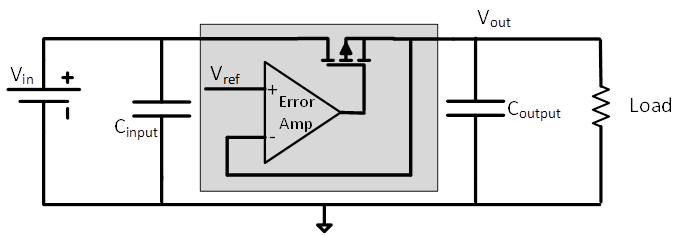Reliable, electrically quiet, cost-effective DC-DC converters.
by Fionn Sheerin, Product Line Manager, Analog Power and Interface Division at Microchip Technology, Inc.
Linear regulators are the simplest regulated DC-DC conversion method. They can be designed to maintain a constant output current or a constant output voltage (which is much more common).
The actual implementation inside the regulator might be a PMOS transistor acting as a voltage controlled current source, forcing the output to be equal to a reference voltage with a carefully designed feedback loop.
For most practical purposes, however, it acts as a variable resistor. If the input voltage, output voltage, or output current changes, the device will adjust its resistance to maintain a constant output. Unlike switching regulators that drive large power transistors from completely on to completely off, linear regulators use small changes to the gate voltage or base current to bias the power device at just the right resistance to regulate the output. The control loop is configured inside the device and—except for specified input and output capacitors—no external compensation is required.
Linear regulators have two key limitations: they are inefficient and they can only reduce the input voltage. Despite these drawbacks, linear regulators dominate the DC-DC landscape and are the most common DC-DC conversion method implemented today. This is mostly due to three advantages: noise, quiescent current, and cost.
Power dissipation is the main drawback of a linear regulator. The power dissipated is a product of the voltage across the device and current flowing through it (P=I*V). Loads that require more current, or large voltage differences from input to output, will be inefficient linear regulator applications.
Another key limitation is that they cannot increase the output voltage or current compared to the input voltage and current. Switching converters, depending on the topology, can increase or decrease the input voltage (or current).
Despite this, linear regulators bring several benefits not commonly found in switching converter implementations. They do not generate harmonic noise like switching regulators or charge pumps. This makes them capable of powering more sensitive loads, such as those used in electronic measurement, audio, or image capturing applications.
Quiescent current is the amount of bias current required to operate the regulator. Battery powered devices, including many wearable or IoT products, may drain more charge when not operating than while performing their intended functions. While it is possible to find switching regulators with 100% duty cycle capabilities and low quiescent currents, the options are limited and expensive. As a result, applications which will spend much of their life in a standby mode can often benefit from the small power drain required to maintain a stable output using a linear regulator.
Finally, linear regulators are often the most economical way to implement a DC-DC conversion. They may require small input and output capacitors but typically do not require external compensation components or feedback resistors commonly used with switching regulators. More importantly, they do not need any magnetic components (inductors or transformers), which can be large and expensive.
Linear regulators are reliable, electrically quiet, cost-effective DC-DC converters that continue to be the most effective way to perform DC-DC conversions for many low-current, wake-on-input, noise-sensitive, or battery powered applications.

